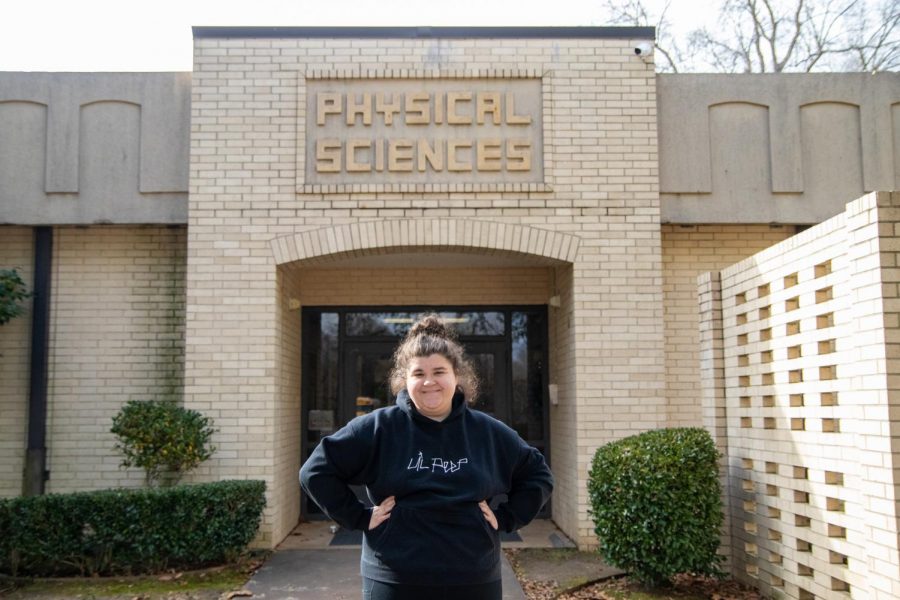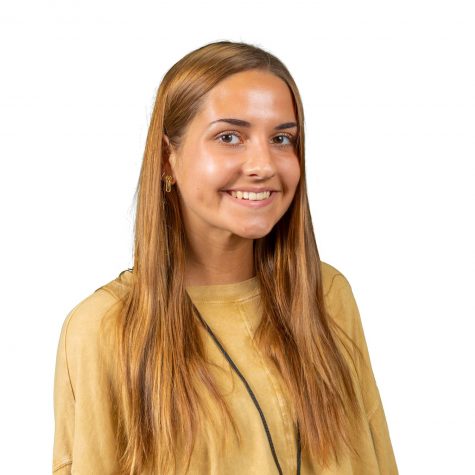Another option
A look into OPTIONS academic alternative high school
Photo by Cayli Clack
OPTIONS student Hannah Spencer stands outside the OPTIONS building. Spencer has spent her sophomore and junior years in the alternative learning facility.
February 10, 2020
There are students whose laughter drowns out the tardy bell as they stroll between classes with friends. There are students who march along the hallways in stampedes, racing across school to avoid earning an absence. Their thundering footsteps can be heard all across campus. They make high school hallways chaotic, but it’s a kind of chaos some students can function in with ease.
Then, there are the students who find it undeniably exhausting.
These students do not find comfort in the unstructured nature of typical public school. Rather, they find the constant stream of students daunting. To them, high school is overpopulated. It lacks options for kids who don’t abide by certain social norms.
There is a place for students like these. It’s a place filled with options scarcely found in the average high school, and it has just the right name to fit this description.
OPTIONS Academic Alternative High School is a TISD secondary school located in Texarkana College. Although they teach the same basic subjects as other public schools, OPTIONS adopts a more individualized atmosphere for its students.
“I think it’s more of a personal setting [than Texas High],” OPTIONS principal Amy Doss said. “I love Texas High, but when you’re here at OPTIONS, it’s really a personal experience for these kids. I know every one of them by name. I know what their habits are. I know them.”
Of these names is junior Hannah Spencer, a former THS student. She transferred schools for the sake of her mental health.
“I have PTSD, anxiety and depression, so [THS] was pretty scary,” Spencer said. “It was loud, and there were too many people for me. I was getting really overwhelmed with all the people and [my surroundings].”
The hectic atmosphere of traditional school was too much for Spencer. Realizing Texas High was not fit for her, she switched to OPTIONS. Her peers there share the same incompatibility with “normal” schools.
“There are people [at OPTIONS] that have anxiety and people there because they have problems with authority, but not to where they have [bad] behavior,” Spencer said. “Just problems enough that they can’t be in a school setting. They need a little bit more attention from the teachers.”
Now, learning among students with similar experiences to hers, Spencer’s classroom environment is calmer than it was at Texas High, easing her anxiety.
“I’m less anxious at school [since I moved to OPTIONS],” Spencer said. “I was anxious about being at school. I don’t like big crowds of people.”
OPTIONS’ instructional techniques discourage big crowds. Instead of learning as a class, this school teaches students one on one.
“[THS teaches] the masses, whereas a lot of times here you get to work with the individual and teach the individual what they need,” Doss said.
OPTIONS teaches students at the individual level through technology. While students at Texas High grab a notebook and pencil at the beginning of each class period, OPTIONS students are more likely to ask for a computer.
“In the mornings, we get everybody going on the computer,” OPTIONS science teacher Heather Barron said. “Everybody’s on a computer here. All the curriculum’s on the computer. We get everybody going and logged in and I just walk around assisting as they need help with questions.”
Students like Spencer feel this kind of independent learning encourages originality.
“I think [learning individually is] healthy for people because sometimes schools take away individuality for kids and make it to where kids can’t really do their own thing anymore,” Spencer said.
A personal approach to education also lets students learn in ways tailored to their needs. This allows students to move through lessons at their own pace.
“As a teacher at OPTIONS, you’re able to help kids with what they need help with,” Doss said. “If they know how to do something, you don’t have to hold their hand through it. They go through and they do the work [themselves]. When they get stuck, that’s when you get to step in and really push them to get through it.”
Students that work past these rough patches can continue their education at a faster rate than they would at Texas High. Some, such as Spencer, are even able to graduate early.
“I think I’m going to take a break before I go to college,” Spencer said. “I’m going to go to college at the same time as the people that graduate the year that I’m supposed to. [On that break] I’m probably going to get a job and save money.”
OPTIONS’ dual credit courses allow teenagers to prepare for college and beyond. Their only current DC classes are in workforce studies, but they plan on adding DC precalculus and college algebra to their list of courses next year.
“I think it’s great that OPTIONS offers DC classes so that students can get a jumpstart on college,” Spencer said. “I personally haven’t taken one because they only have certain classes you can take, and I’m not really interested in any of the ones offered.”
OPTIONS students who enroll in higher education may encounter more extracurricular opportunities than they currently have. Their campus does not offer any after school clubs or organizations.
“I think it would be better if they could incorporate [extracurriculars], but I understand the reasons why they don’t,” Spencer said. “There are reasons why people are at OPTIONS, other than the reasons why I’m there.”Some teenagers attend OPTIONS due to mild behavioral problems. While these students may concern their teachers at first, watching them succeed is a rewarding experience for their advisors.
“[There are] certain students that come to our school and you are a little worried about how they’re going to fit into your class and are they going to be a disruption,” Barron said. “They start off a little rough. You think, ‘This kid is never going to graduate.’ Then, slowly but surely, they’ll find their way here.”
An OPTIONS student’s way to success may seem unexpected, filled with as many twists and turns as the journey of any other high school student. However, given the right tools for success, these “problem” students can rise to the occasion.
“We’ve got some of the best kids in the district,” Doss said. “We’ve got some of the smartest kids in the district. Some of them just aren’t as outgoing and don’t want to do the extracurriculars.”
















